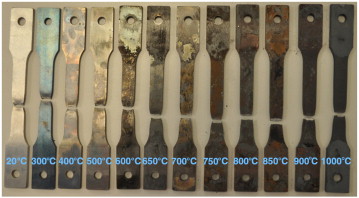9/11 has spiked the interest in performance of steel constructions under fire. In her PhD research Dr. Xuhong Qiang tested a new very high strength steel.
Steel used for building construction is mostly a middle-strong mild variety, as it has been for decades. In the mean time, says Dr. Xuhong Qiang (CEGS), much stronger steels have been developed. VHSS (very high strength steel) for example is used for shipbuilding, offshore engineering and for cranes. Yet it’s seldom used for building constructions, due to the lack of design guidelines.
And yet VHSS promises distinctive advantages such as less material needed, more slender constructions and less welding hours.
Qiang has tested S960 steel (which yields at a tensile stress of at least 960 N/mm2) under a variety of temperatures up to 1000 Celsius. After 9/11, the (residual) strength of steel after fire has become an important property. The laboratory test consisted of heating a sample to a set temperature between 100 and 1000 Celsius. Having it cool down in ten minutes, and then tear it to pieces at the tensile test.


After it has been heated up to 600 degrees and subsequently cooled down, the new steel performs smoothly, hardly losing any of its strength. Qiang concludes that VHSS beams from a burnt-out building may safely be reused up to 90 percent of their original strength.
At temperatures higher than 600 degrees however, the residual strength drops significantly to about 70 percent of its initial value. By curve-fitting Qiang produces a quadratic function that describes the material’s elastic modules (defined as stress in N/mm2 over strain) as a function of the exposure temperature.
As long as they know the exposure temperature, engineers can use the formula to calculate the residual strength of salvaged beams they wish to reuse.


Arguably more important than the ultimate strength at which the metal breaks is the so-called yield strength at which the material starts to deform. Qiang has done a large number of tests with full sized metal beams bolted at right angles. She submitted the connections to high temperatures and large stresses to induce deformations.
She found that one can replace the traditional mild steel endplate on a H-shaped beam with a thinner endplate of very high strength steel while maintaining the same quality of the connection under fire (same load resistance, same failure moment and same or even better rotational capacity).
Qiang concludes that before the promising new high strength steels can safely be applied, more research is needed with larger constructions under fire. She also states that existing guidelines for the residual strength of reused beams (such as the Eurocode 3) need to be revised for high strength steels above 600 degrees.
Xuhong Qiang, Behaviour of High Strength Steel Endplate Connections in Fire and after Fire, 16 July 2013, PhD supervisor Prof. Frans Bijlaard.
Xuhong Qiang, Frans S.K. Bijlaard, Henk Kolstein, Post-fire performance of very high strength steel S960, Journal of Construction Steel Research 30 October 2012, doi:10.1016/j.jcsr.2012.09.002



Comments are closed.